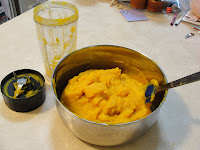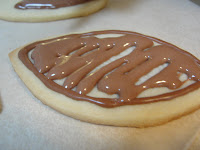Little miss loves pumpkins, so we couldn't resist picking up a fe
 w this past weekend. We grabbed three - two big and one smaller one. Originally, little miss told us that she wanted these pumpkins to be for decoration purposes, to place on our front steps and make the house look ready for the season. But then she changed her mind. And wanted to eat one.
w this past weekend. We grabbed three - two big and one smaller one. Originally, little miss told us that she wanted these pumpkins to be for decoration purposes, to place on our front steps and make the house look ready for the season. But then she changed her mind. And wanted to eat one.After cutting the pumpkin in half, it was little miss's job to scoop out the see
 ds. The seeds were set aside in their own bowl, then I helped her scoop out the rest of the stringy pulp. Once the pumpkin halves were ready, they were placed cut-side down on a cookie sheet and baked in a 350 degree oven for, well, I didn't really time it, but it was probably about half an hour our so, until I could easily pierce the skin with a fork and the flesh was nice and soft.
ds. The seeds were set aside in their own bowl, then I helped her scoop out the rest of the stringy pulp. Once the pumpkin halves were ready, they were placed cut-side down on a cookie sheet and baked in a 350 degree oven for, well, I didn't really time it, but it was probably about half an hour our so, until I could easily pierce the skin with a fork and the flesh was nice and soft.Once the pumpkin cooled enough to
 handle, it was time to turn the fruit into a nice smooth puree. This is most easily accomplished with a food processor. In the absence of said appliance, I put my mini-blender to work. And it earned its stripes that day, with how many batches I had to do to successfully puree all of the fruit, but after much scooping and blending, we soon had a nice bowl full of fresh, smooth pumpkin puree, ready to be used in all sorts of recipes.
handle, it was time to turn the fruit into a nice smooth puree. This is most easily accomplished with a food processor. In the absence of said appliance, I put my mini-blender to work. And it earned its stripes that day, with how many batches I had to do to successfully puree all of the fruit, but after much scooping and blending, we soon had a nice bowl full of fresh, smooth pumpkin puree, ready to be used in all sorts of recipes.And little miss knew exactly what she wanted: cupcakes. I hopped online to look for a recipe, and soon found one that looked delicious. And familiar. I couldn't figure out why it looked familiar to me, as I know I have never made pumpkin cupcakes before... until I looked at my listing of bookmarked sites, and realized that I had seen this recipe before, and had bookmarked it for future trial. Well, hey - I knew I had the recipe that I wanted to try!
This was a really in
 teresting recipe, in that it is not put together the way most cake/cupcake recipes that I am used to do. Usually, the ingredients are added in a specific order, mixed for specific, and relatively short, periods of time. Nope - not with this one. In this recipe, all of the ingredients are added to the bowl at the same time, and then the mixer is put to work. For 25 minutes. I was super glad to have the KitchenAid for this one - I can't imagine either mixing this by hand or even holding a hand-mixer to this for that long. And with the consistent, strong mixing of the stand mixer, the result was a very smooth batter that looked and smelled fantastic.
teresting recipe, in that it is not put together the way most cake/cupcake recipes that I am used to do. Usually, the ingredients are added in a specific order, mixed for specific, and relatively short, periods of time. Nope - not with this one. In this recipe, all of the ingredients are added to the bowl at the same time, and then the mixer is put to work. For 25 minutes. I was super glad to have the KitchenAid for this one - I can't imagine either mixing this by hand or even holding a hand-mixer to this for that long. And with the consistent, strong mixing of the stand mixer, the result was a very smooth batter that looked and smelled fantastic.
One of the first things that we noticed upon taking the cupcakes out of the oven was the interesting way in which they had risen. Most of the cupcakes not only rose in the middle, but also rose up around the edges, creating something of a crown around the cupcake top. Very interesting. But I knew it wouldn't make too much of a difference what the tops looked like, as we were not done - we really wanted to try the cinnamon brown sugar buttercream frosting recipe that was posted with the cupcake recipe.
The frosting recipe,
 as written, calls for a combination of butter and shortening. Unfortunately, I do not currently have shortening in my pantry, so I made my frosting using all butter, rather than a combination. The end result, though, was absolutely delicious, and was the perfect match for the cupcakes. I think the frosting would also work really well for, say, a banana cake, so I definitely plan on making it again.
as written, calls for a combination of butter and shortening. Unfortunately, I do not currently have shortening in my pantry, so I made my frosting using all butter, rather than a combination. The end result, though, was absolutely delicious, and was the perfect match for the cupcakes. I think the frosting would also work really well for, say, a banana cake, so I definitely plan on making it again.But wait - there's more!
We had plenty of pumpkin puree leftover, so I decided to try somethi
 ng special for breakfast the next morning. Little miss and I added some of our pumpkin puree, along with some cinnamon and nutmeg, to our regular pancake recipe. Oh my, what a fantastic breakfast treat. I can't think of a better breakfast for a cool, fall morning than pumpkin spice pancakes with pure maple syrup. We will definitely make these again.
ng special for breakfast the next morning. Little miss and I added some of our pumpkin puree, along with some cinnamon and nutmeg, to our regular pancake recipe. Oh my, what a fantastic breakfast treat. I can't think of a better breakfast for a cool, fall morning than pumpkin spice pancakes with pure maple syrup. We will definitely make these again.And in case you are curious, we also roasted up the seeds from the pumpkin, so as to enjoy as much of our first pumpkin as possible. I am really looking forward to the rest of pumpkin season!
Pumpkin Pound Cake Cupcakes
(from My Kitchen Addiction)
1 cup sugar
1/2 cup packed brown sugar
2 cups all purpose flour
2 teaspoons baking powder
1/2 teaspoon salt
1/2 teaspoon cinnamon
1/4 teaspoon nutmeg
4 eggs
1/2 cup milk
3/4 cup pumpkin puree
1 stick unsalted butter, softened
Preheat oven to 350 degrees and line two standard muffin pans with cupcake liners (or spray well with non-stick cooking spray)
Combine all ingredients (yup, all of 'em!) in the bowl of your stand mixer. Beat on medium for 20 minutes.
Once the batter is smooth, fill each cupcake well (lined or sprayed) about 2/3 full with batter.
Bake for 20 minutes, until a toothpick inserted into the center comes out clean.
Cool the cupcakes in the pan for a few minutes, then transfer them to wire racks to cool completely.
Cinnamon Brown Sugar Buttercream Frosting
(only slightly adapted from My Kitchen Addiction)
3/4 cup (1 1/2 sticks) unsalted butter, softened
1/3 cup brown sugar, packed
1/2 teaspoon cinnamon
3 cups powdered sugar (may need more)
3 tablespoons half and half (more or less)
In the bowl of your stand mixer with the whisk attachment, beat the butter until light and fluffy. Add the brown sugar and cinnamon and whisk until well combined.
Gradually add the powdered sugar, 1/2 cup at a time. Alternately add a little bit of the half and half, whipping the icing on medium-high speed after each addition, until the desired consistency is reached.
Frost cupcakes once they are completely cooled.
Enjoy!












































